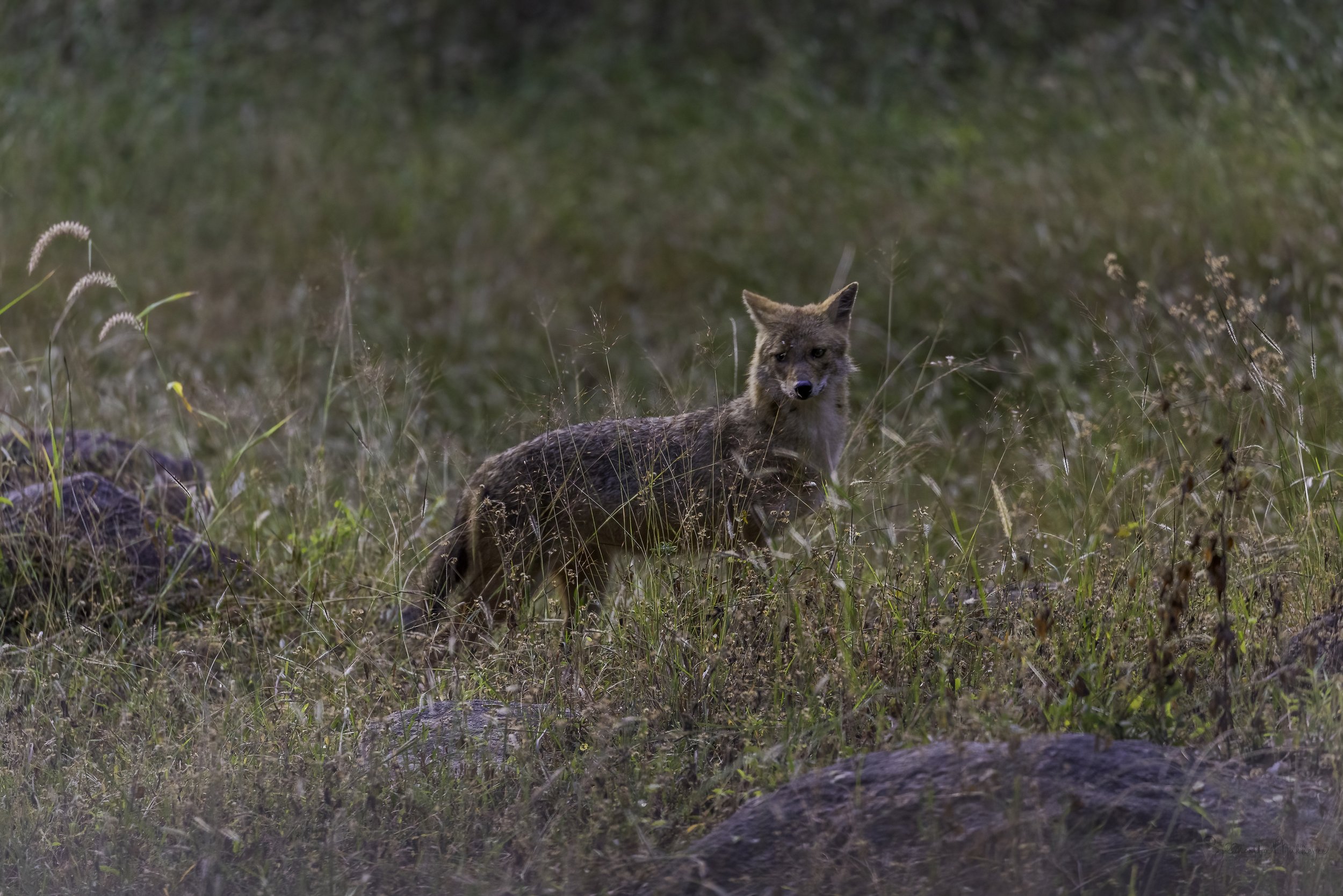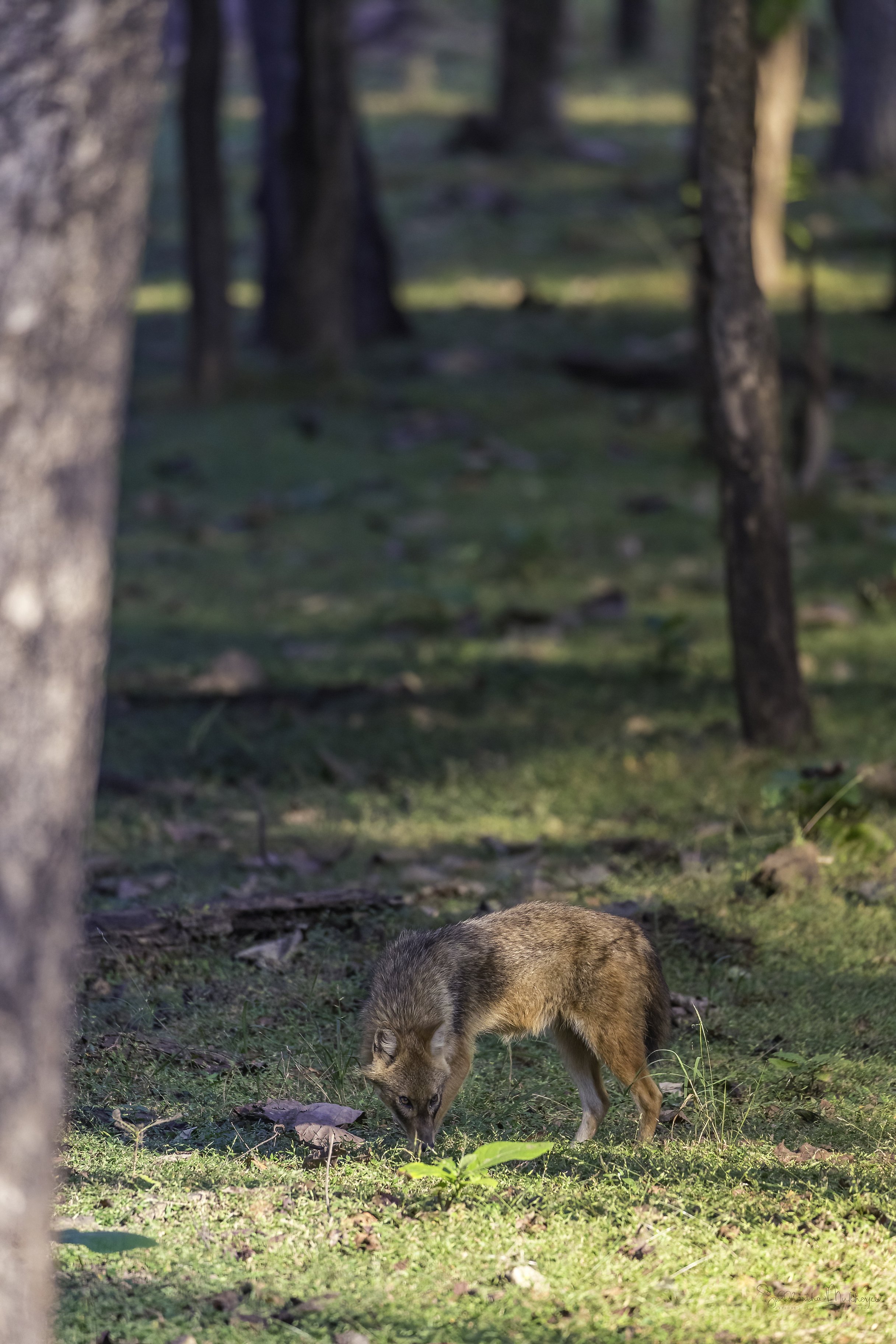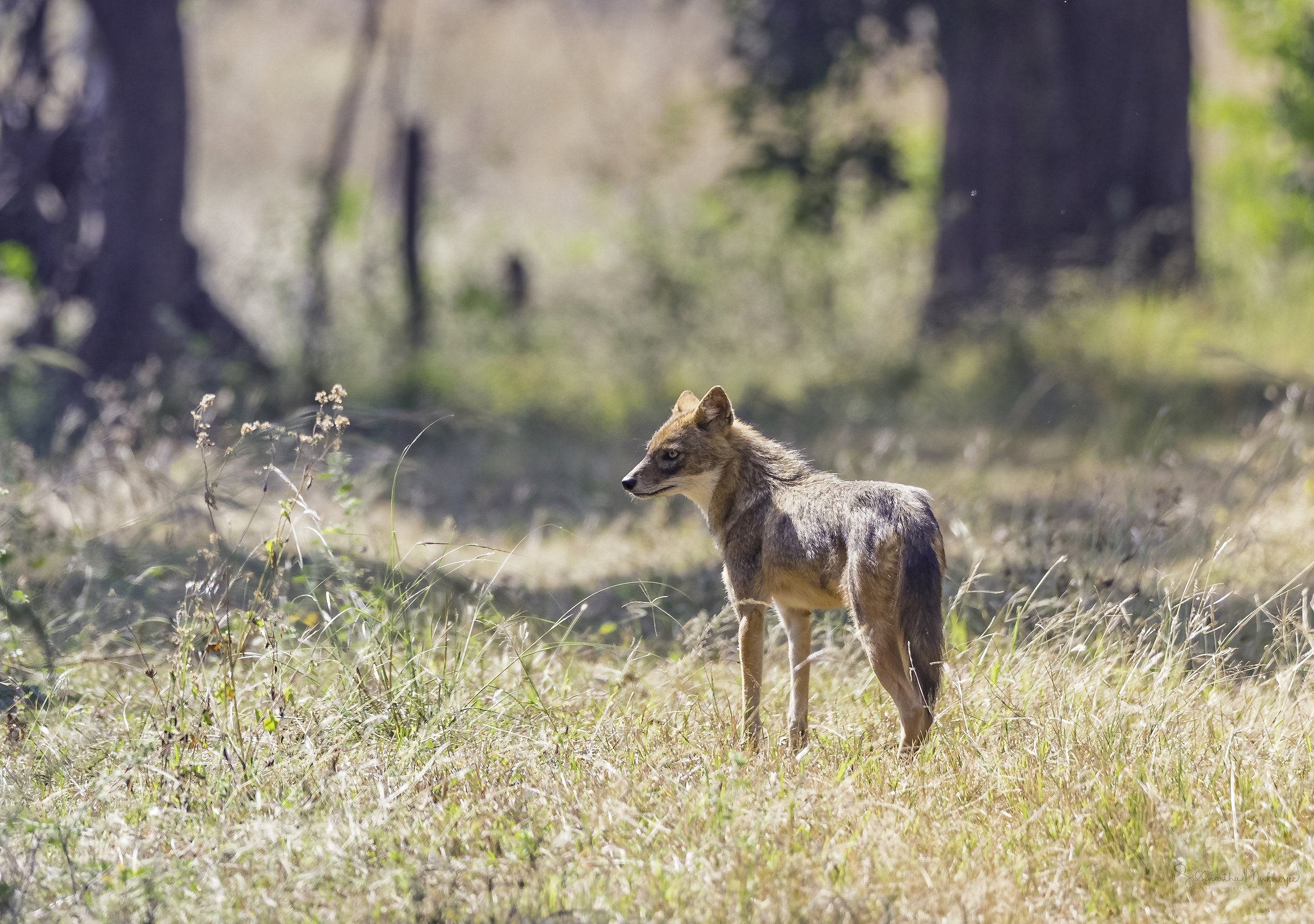The Jackal
Canis aureus indicus
Pench National Park
The Indian Jackal (Canis aureus indicus), also known as the Himalayan Jackal, is a subspecies of golden jackal native to Pakistan, India, Bhutan, Burma and Nepal. This is the only species of Jackal on the Indian subcontinent and it is found in almost every habitat in the country, inspiring numerous folk stories and songs, but also a few questionable practices that have led to poaching of the wild canid. These stories and songs are particularly interesting because they teach certain ecological aspects of the species like their distribution and diet through them. In one such story from Goa, a jackal climbs up the jamun tree to feed on ripened berries. The neighbourhood children call out, “Kolo mama, kolo mama! Amkai thodi jamblam udoi re.” (Uncle Jackal, please throw down some berries for us!) Instead, the jackal has a good meal of the jamun and throws the seeds at the children. This indicates that jackals may disperse seeds away from the parent plant as droppings, thus reducing competition and increasing chances of the survival of those seeds. Their role as fruit-eating mammals and consequently seed dispersers in their diverse habitats in India is less recognised and under-appreciated.
The jackal is a small-sized mammal compared to their closest relatives, the wolves and the Dhole. And as the saying goes “when the tiger kills, the jackal profits.” To read more about the Tiger click here.
Pench National Park
Pench National Park, nestled in the heart of India in the lower southern reaches of the Satpura hills, sprawls a massive 758 km² across the states of Madhya Pradesh & Maharashtra. In Madhya Pradesh it is located in the districts of Seoni and Chhindwara. Named after the pristine River Pench it was immortalised by Rudyard Kipling in his Jungle Book. Every year millions make their way here to spot Akela (the Indian Wolf), Baloo (the Sloth Bear), Bagheera (the Black Panther) and Shere Khan (the Royal Bengal Tiger). It was declared a sanctuary in 1965 and elevated to the status of national park in 1975 and enlisted as a tiger reserve in 1992. The area has always been rich in wildlife dominated by fairly open canopy, mixed forests with considerable shrub cover and open grassy patches. The high habitat heterogeneity favours a high population of Chital and Sambhar. Pench tiger reserve has highest density of herbivores in India (90.3 animals per km²).
Pench has a glorious history of natural wealth and unique cultural richness described in several classics ranging from the Ain-e-Akbari to the Jungle Book. Several natural history books like Strendale’s “Seonee - Camplife in the Satpuras” & Forsyth’s “Highlands of Central India” present a detailed panorama of these forests.
Pench National Park was also the location used by the BBC for the innovative wildlife series Tiger: Spy in the Jungle, a three-part documentary narrated by Sir David Attenborough which used concealed cameras, placed by elephants, in order to capture intimate tiger behaviour and also retrieved footage of various other fauna in the reserve. The programme aired for the first time in March 2008 and ended a month later.
The forest, lush and green in the monsoon, also harbours a wide range of faunal species some of which figure prominently in the IUCN Red List. Our story, however, is about one of the most opportunistic feeders known to man - the Jackal - specifically the Indian Jackal (Canis aureus indicus).
Phylogenetic Tree of the Wolf-like canids
The Canid family - wolves, coyotes, jackals, foxes, domestic dogs and others - are so familiar to us, and have been so intensively studied for so long that one might assume that we know almost everything there is to know about them. But a paper published in Current Biology sometime in July 2015 belies that assumption. This paper describes the meticulous research conducted by an international team of experts who report a surprising discovery: a new species of wolf.
According to the authors, two golden jackal populations - one in Eurasia and the other in Africa - split more than one million years ago, which is sufficient to formally recognise each as separate species. Further, after exhaustive DNA analyses, the authors were surprised to learn that African golden jackals are more closely related to grey wolves, even though there are no grey wolves in Africa and even though grey wolves and African golden jackals look dramatically different. Adding to the confusion, African golden jackals are strikingly similar in appearance to their more distant relative, the Eurasian golden jackal. This strong physical similarity has long been the source of confusion over these animals’ taxonomy and evolutionary relationships. As a result of this study, the authors propose that the African golden jackal be renamed the African golden wolf, Canis anthus.
My grateful thanks to my companions - Angad, Rishi, Rahi & Golu - for bearing with me and my excesses. This would not have been possible without their help and incredible skills.
The Indian Jackal
The jackal appears prominently in Indian and Nepali folklore, where they often take over the role of the trickster taken by the red fox in Europe and North America. In the Panchatantra in the story of The Blue Jackal has the jackal disguising itself with blue paint as Neelkanth, the guardian of all animals, and tricking the other animals into providing food for him, so that he may continue protecting them. He is driven away once the monsoon washes the paint from him. In some tales, jackals are portrayed as malevolent and treacherous. The Mahabharata describes the story of a jackal who sets his friends, the tiger, wolf, mongoose and mouse against each other, just so he can eat a gazelle without sharing it. In Hinduism, the name of Shiva itself means jackal, and a jackal was often illustrated as the consort of goddess Kali. Jackals are the vahanas (mounts) of various Hindu and Buddhist deities, particularly in Tibet while in India the goddess Durga was often linked to the jackal.
Golden Jackal - Range & Geographical Distribution
In Rudyard Kipling's The Jungle Book, the character Tabaqui is a jackal despised by the Seoni wolf pack, due to his mock cordiality, scavenging habits and his subservience to Shere Khan. He appears at the beginning, visiting Mowgli's adoptive parents, the wolves Rama & Raksha, who are clearly annoyed by his presence, and announces that Shere Khan, the tiger, is hunting in their territory. Tabaqui is later killed by one of Mowgli's 'siblings', Grey Brother, who crushes his back.
As the name Golden Jackal suggests, the coat is a golden brown with a bit of mottled fur in between. In winters, however depending on the region, a darker coat can be seen. They are quite widespread across India. Right from the Himalayan foothills, down to the Western Ghats.
Distribution range of wild Canis species in India along with sampling locations. The golden jackal distribution was obtained from the IUCN species database (http://maps.iucnredlist.org/map.html?id=3744, accessed 16 June 2021), while the Indian and Himalayan wolf range is depicted from locations and maps available in Aggarwal et al. 2003, Jhala 2003 and Sharma et al. 2004.
Its fur is a mixture of black and white, with buff on the shoulders, ears and legs. The buff colour is more pronounced in specimens from high altitudes. Black hairs predominate on the middle of the back and tail. The belly, chest and the sides of the legs are creamy white, while the face and lower flanks are grizzled with grey fur. It is generally of a richer colour than the common jackal, the pale areas of the back being of a pale buff colour rather than whitish or silver. Black specimens have been reported in Bengal. Adults are slightly larger than common jackals, and grow to a length of 100 cm (39 in), 35–45 cm (14–18 in) in height and 8–11 kg (18–24 lb) in weight.
The typical habitat of the golden jackal can be anywhere from the dry deciduous forests, semi-arid regions to agricultural lands and close to human settlement habitats. It inhabits lowlands on the outskirts of towns, villages and farms, where they shelter in holes among ruins or dense brush. Except during the hot months of the Indian summer, the Indian jackal usually only leaves its den at dusk and retires at dawn. Though primarily a scavenger which subsists on garbage and offal, it will supplement its diet with rodents, reptiles, fruit and insects. It will form small packs when hunting small deer and antelopes. Although it will occasionally kill poultry and young kids and lambs, it is largely harmless. When wild prey is scarce, it will usually take to eating vegetable matter, including maize and Jujube fruit. It is extremely harmful to the vineyards of western India, and is known to eat large quantities of coffee beans in the rolling coffee and pepper plantations of Wayanad.
Golden jackals have a flexible diet — utilising a variety of food sources that vary according to the habitat they live in. Besides small-sized prey and carcass remains, vegetation in the form of grass, leaves and fruit also constitute a part of their diet. In fact, a study from the coastal forests of Andhra Pradesh and Tamil Nadu found that jackals consume the fruits of up to 22 plant species including jamun. Jackals may disperse seeds away from the parent plant as droppings, thus reducing competition and increasing chances of the survival of those seeds. Their role as fruit-eating mammals and consequently seed dispersers in their diverse habitats in India is less recognised and under-appreciated.
Lone jackals expelled from their pack have been known to form commensal relationships with tigers. These solitary jackals are known as kol-bahl, bhálú in southern India, phéall, phao, pheeow or phnew in Bengal and ghog in other regions. They will attach themselves to a particular tiger, trailing it at a safe distance in order to feed on the big cat's kills. A kol-bahl will even alert a tiger to a kill with a loud pheal. Tigers have been known to tolerate these jackals: one report describes how a jackal confidently walked in and out between three tigers walking together a few feet away from each other.
The golden jackal (Canis aureus) is the most widespread wild canid in the Indian sub-continent. A large geographic range, and perhaps their relatively stable populations, put golden jackals in the ‘Least Concern’ category of the IUCN Red List. In India, jackals are protected under Schedule II Part II of the Wild Life Protection Act ‘WLPA’ (1972). Poaching of relatively widespread or less-charismatic species is often overlooked or underestimated by wildlife agencies, even if they may form a considerable portion of wildlife seizures. Worryingly, there also exists a largely under-researched demand and supply of wildlife products fuelled by superstitious beliefs that are reinforced by commercial traders of ritualistic worship material, astrologers, and sorcery or ‘black magic’ practitioners.
The ‘jackal horn’ or siyar singhi in Hindi and nari kombu in Tamil/Kannada/Telugu, appears to be extracted from the golden jackal’s skull. In reality, the jackal does not have a horn. The ‘jackal horn’ is likely a deformity on the jackal’s head, or in many cases, a tuft of hair from a jackal or a domestic animal, stuck together in the shape of a ball. Several online advertisements on popular e-commerce sites reveal that the ‘jackal horn’ trade is internet-mediated, consisting of local, regional and international stakeholders. Some popular online retailers based in the US, UK, Germany and Singapore also list siyar singhi for sale on their websites.
YouTube serves as a vehicle for traders of ‘jackal horn’ to make unscientific claims, create a demand and then negotiate with potential buyers. The endorsement of hatha jodi (dried copulatory organ of monitor lizard, also used in superstitious practices) together with siyar singhi in these online videos raises concerns of a larger, multi-species trade network. It also draws attention to the potential role of social media and e-commerce portals in facilitating wildlife crime, where sellers can freely post detailed videos of product authenticity and also demonstrate its use in superstitious rituals. While belief in superstitions and sorcery is a key driver of golden jackal trade in India, there is need for better understanding several aspects of the trade. A thorough on-ground research is crucial to tackling this threat. Detailed information about ‘jackal horn’ seizures, like quantity, modus operandi, transit modes, transit routes, and potential destinations can help fill existing gaps in knowledge.
But the lack of comprehensive data cannot delay action against illegal jackal trade in India. Citizens and the public at large must actively discourage online e-commerce portals such as Amazon and eBay and social media platforms like Facebook and YouTube by writing to them and demanding for strict screening of posts that involve trade of wild animal parts through their websites. Increasing recognition of the global implications of illegal wildlife trade on public health and economies will draw a much-needed attention towards research and conservation efforts that are inclusive of less charismatic and under-valued species.
Currently, we do not know enough about the true population status of jackals in the country to conclusively determine how these different threats impact populations. Contributing to citizen science initiatives such as the Wild Canids-India Project is a great way to get involved in bettering our understanding of golden jackals. The WCIP website allows you to report sightings of jackals (and other canids) by uploading photographs and location details.
Citation: Chawla, M.M., A. Srivathsa, P. Singh, I. Majgaonkar, S. Sharma, G. Punjabi & A. Banerjee (2020). Do wildlife crimes against less charismatic species go unnoticed? A case study of Golden Jackal Canis aureus Linnaeus, 1758 poaching and trade in India. Journal of Threatened Taxa, 12(4), 15407-15413.
With that said lets move onto the gallery of this beautiful animal.
‡‡‡‡‡
Related Posts





































